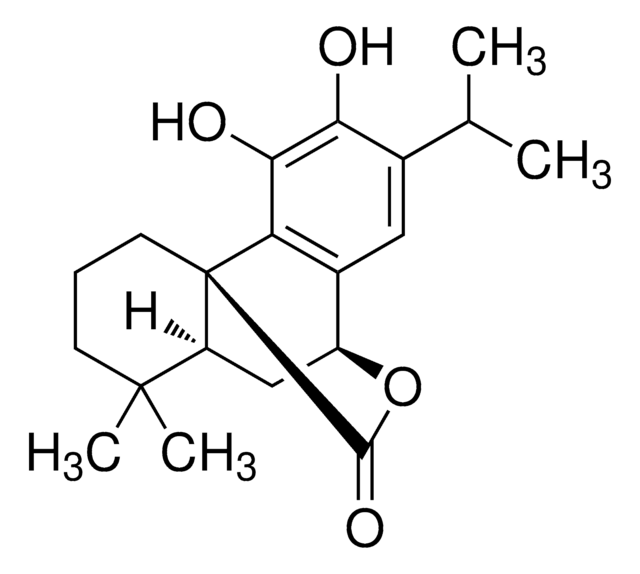推薦產品
生物源
Rosemarinus officinalis L.
形狀
powder
應用
metabolomics
vitamins, nutraceuticals, and natural products
運輸包裝
dry ice
儲存溫度
−20°C
SMILES 字串
CC(C)c1cc2[C@@H]3C[C@H]4C(C)(C)CCC[C@]4(C(=O)O3)c2c(O)c1O
InChI
1S/C20H26O4/c1-10(2)11-8-12-13-9-14-19(3,4)6-5-7-20(14,18(23)24-13)15(12)17(22)16(11)21/h8,10,13-14,21-22H,5-7,9H2,1-4H3/t13-,14-,20+/m0/s1
InChI 密鑰
XUSYGBPHQBWGAD-PJSUUKDQSA-N
尋找類似的產品? 前往 產品比較指南
一般說明
應用
訊號詞
Warning
危險聲明
危險分類
Skin Sens. 1
儲存類別代碼
11 - Combustible Solids
水污染物質分類(WGK)
WGK 3
閃點(°F)
Not applicable
閃點(°C)
Not applicable
從最近期的版本中選擇一個:
分析證明 (COA)
Lot/Batch Number
客戶也查看了
Saeed Samarghandian et al.
BMC complementary and alternative medicine, 17(1), 249-249 (2017-05-06)
Oxidative stress through chronic stress destroys the brain function. There are many documents have shown that carnosol may have a therapeutic effect versus free radical induced diseases. The current research focused the protective effect of carnosol against the brain injury
Seitaro Nakagawa et al.
Antibiotics (Basel, Switzerland), 9(4) (2020-04-05)
Staphylococcus aureus is an opportunistic pathogen and a common cause of skin infection. S. aureus also plays a role in the pathogenesis of the chronic inflammatory skin disease, atopic dermatitis. S. aureus virulence involves activation of the quorum sensing agr
Marcos Roberto de Oliveira
Molecular neurobiology, 53(9), 6155-6168 (2016-11-01)
Carnosic acid (CA) and carnosol are the major diterpenes found in Rosmarinus officinalis (rosemary), a culinary spice. CA and carnosol account for over 90 % of its anti-oxidant activity in rosemary leaves. The diterpenes exert anti-oxidant, anti-inflammatory, and anti-carcinogenic activities, and
Kyung-Soo Chun et al.
Journal of cancer prevention, 19(2), 103-110 (2014-10-23)
Cancer is an unbeaten health challenge for the humankind. After striving for decades to find a cancer cure, attention has now been shifted to reduce the morbidity and mortality from cancer by halting the course of tumor development. Numerous bioactive
Lucia Cattaneo et al.
PloS one, 10(7), e0132439-e0132439 (2015-07-16)
Rosemary (Rosmarinus officinalis L.) has been used since ancient times in traditional medicine, while nowadays various rosemary formulations are increasingly exploited by alternative medicine to cure or prevent a wide range of health disorders. Rosemary's bioproperties have prompted scientific investigation
Active Filters
我們的科學家團隊在所有研究領域都有豐富的經驗,包括生命科學、材料科學、化學合成、色譜、分析等.
聯絡技術服務











